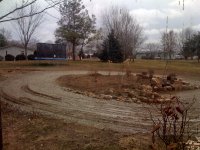I put in a new gravel turn around this past spring and all was good up till yesterday. All during the year it appeared to be draining good and very well packed up till we had a bit of a warm spell yesterday. I went almost 6 months with lots of traffic on the drive and plenty of very wet conditions and just like that, now its mush (now frozen mush). Building of the drive consisted of box blading down about 6" and laying in some large stone (I believe it was used 52's) about 5" thick. I did not believe I would have any drainage issues. Before the drive was added we would just drive in the lawn in this very same spot and it was fine, no ruts nothing (very well packed). Now I'm in worse shape than before. In the spring I was planning on adding some #9 top stone but I think that has now changed to another load of 52's. Where do you think I went wrong and what would you do to fix it. Is this a typical issue when the frost within the soil melts and I assume there is an excessive amount of water trapped?
And to think I was proud of my very first tractor project.
And to think I was proud of my very first tractor project.
